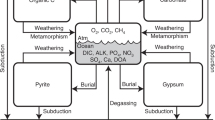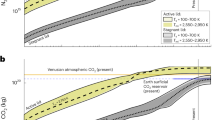Abstract
Arising from M. T. Rosing, D. K. Bird, N. H. Sleep & C. J. Bjerrum Nature 464, 744–747 (2010)10.1038/nature08955
Rosing and others1 recently proposed a new model for the early Earth’s atmospheric composition. They suggest, on the basis of mineral assemblages in sedimentary rocks, that atmospheric CO2 and CH4 concentrations have been consistently overestimated. This proposal is intriguing, given that high concentrations of these gases are traditionally considered to be the solution to the ‘faint young Sun paradox’ of why the Earth did not freeze over in our Sun’s youth when solar luminosity was greatly decreased. Rosing and others1 instead invoke a decreased planetary albedo during the Earth’s early history. New insights into this problem, which has long captivated those interested in the Earth’s early climate and biological history, are welcome. However, we believe that the arguments presented by Rosing and others1 for roughly modern values of the partial pressure of CO2 ( ) are not robust.
) are not robust.
Similar content being viewed by others
Main
A fundamental assumption in the model of Rosing and others1 is that the coexistence of the mineral phases siderite (FeCO3) and magnetite (Fe3O4) in banded iron formations (BIFs) represents an assemblage that is nearly in thermodynamic equilibrium with the atmosphere, placing stringent constraints on the partial pressures of both CO2 and H2. The mineralogy of some BIFs is dominated by FeCO3 (ref. 2), whereas others have mineralogies dominated by ferric oxide phases3. However, in well-studied BIFs with mixed Fe3O4–FeCO3 phases (such as the Kuruman, Hamersley and Old Wanderer iron formations), carbon and iron isotope work4,5 indicates that these minerals did not precipitate in isotopic equilibrium with the ocean. Therefore, diagenetic conditions controlled mineral formation; there is evidence for an initial rain of ferric oxides and secondary formation of reduced and mixed-valence iron minerals during early or later-stage diagenesis4,5. This is important given that dissimilatory iron-reducing bacteria generate Fe3O4 even at very high aqueous carbon dioxide concentrations and headspace values of [∑CO2] ≈ 50 mM (ref. 6) and  ≈ 0.2 atm (ref. 7). Mixed Fe3O4–FeCO3 assemblages develop as a result of an imbalance between rates of non-reductive ferric oxide dissolution, Fe2+ transport, and rates of Fe3+–Fe2+ conversion6,7,8. Therefore,
≈ 0.2 atm (ref. 7). Mixed Fe3O4–FeCO3 assemblages develop as a result of an imbalance between rates of non-reductive ferric oxide dissolution, Fe2+ transport, and rates of Fe3+–Fe2+ conversion6,7,8. Therefore,  values very much above the modern value do not preclude the formation of magnetite.
values very much above the modern value do not preclude the formation of magnetite.
In addition, the authors assume that both the atmospheric partial pressure and aqueous concentration of H2 will be controlled by hydrogenotrophic methanogenesis. However, the preservation of ferric oxides, together with a paucity of organic carbon in most BIFs, strongly suggests that H2 pressures or concentrations would instead be buffered most often by dissimilatory iron-reducing bacteria in BIF diagenetic environments. This would decrease the aqueous concentration of H2 significantly9, changing the relevant stability boundary to Fe2O3–FeCO3. For instance, a threshold [H2] of about 0.1 nM would yield  estimates between about 30–100 PAL (present atmospheric level) at 25 °C–35 °C (Fig. 1a of ref. 1). We view this as a non-trivial difference given the attendant implications for climatologically plausible CH4/CO2 ratios and atmospheric CH4 concentrations10.
estimates between about 30–100 PAL (present atmospheric level) at 25 °C–35 °C (Fig. 1a of ref. 1). We view this as a non-trivial difference given the attendant implications for climatologically plausible CH4/CO2 ratios and atmospheric CH4 concentrations10.
Finally, even if we were to assume a simple thermodynamic control regulated by  (via methanogenesis) and
(via methanogenesis) and  , it is unlikely that the coexistence of Fe3O4 and FeCO3 in BIFs provides any direct evidence regarding the chemistry of a surface ocean that is nearly in equilibrium with the overlying atmosphere. There is overwhelming petrographic evidence that the Fe3O4 observed in many BIFs is metamorphic or late-stage alteration product11,12,13. Indeed, the co-existence of Fe2O3–Fe3O4–FeCO3 assemblages and significant mineralogical variability on small spatial scales in many BIFs suggest either the formation and preservation of mineral phases out of thermodynamic equilibrium with the ambient ocean–atmosphere system or secondary/metamorphic alteration. Although we do not suggest that a single depositional model applies for all BIF occurrences throughout the Earth’s history, we do contend that many of the basic processes operating during their formation (microbial Fe oxidation/reduction, organic-matter remineralization in sediments, and metamorphism) are pervasive if not ubiquitous and should be considered in any attempt to relate BIF mineralogy to atmospheric composition.
, it is unlikely that the coexistence of Fe3O4 and FeCO3 in BIFs provides any direct evidence regarding the chemistry of a surface ocean that is nearly in equilibrium with the overlying atmosphere. There is overwhelming petrographic evidence that the Fe3O4 observed in many BIFs is metamorphic or late-stage alteration product11,12,13. Indeed, the co-existence of Fe2O3–Fe3O4–FeCO3 assemblages and significant mineralogical variability on small spatial scales in many BIFs suggest either the formation and preservation of mineral phases out of thermodynamic equilibrium with the ambient ocean–atmosphere system or secondary/metamorphic alteration. Although we do not suggest that a single depositional model applies for all BIF occurrences throughout the Earth’s history, we do contend that many of the basic processes operating during their formation (microbial Fe oxidation/reduction, organic-matter remineralization in sediments, and metamorphism) are pervasive if not ubiquitous and should be considered in any attempt to relate BIF mineralogy to atmospheric composition.
Rosing et al.1 rightly point out that some previous work (see references in ref. 1) based on mineral stability in palaeosol profiles has also suggested low  values. However, this work contrasts with experimental studies14, indicating that mineral stability as a function of
values. However, this work contrasts with experimental studies14, indicating that mineral stability as a function of  during the formation of ancient soil profiles is not fully understood. Nonetheless, the numerical model proposed by Rosing et al.1 has a number of important implications. For example, by implicitly linking the Earth’s planetary albedo to the oxidation state of the atmosphere, the model may provide a new mechanism for explaining the inception of widespread glaciation following changes in Proterozoic atmospheric oxygen content. Such considerations are novel and will be fruitful to examine, and it is likely that any explanation for the clement early Earth will involve a complex interplay of forcings and feedbacks. However, we conclude that early Precambrian atmospheric
during the formation of ancient soil profiles is not fully understood. Nonetheless, the numerical model proposed by Rosing et al.1 has a number of important implications. For example, by implicitly linking the Earth’s planetary albedo to the oxidation state of the atmosphere, the model may provide a new mechanism for explaining the inception of widespread glaciation following changes in Proterozoic atmospheric oxygen content. Such considerations are novel and will be fruitful to examine, and it is likely that any explanation for the clement early Earth will involve a complex interplay of forcings and feedbacks. However, we conclude that early Precambrian atmospheric  levels remain poorly constrained and that increased levels of atmospheric gases (CO2, CH4, C2H2) remain a compelling solution to the ‘faint young Sun paradox’.
levels remain poorly constrained and that increased levels of atmospheric gases (CO2, CH4, C2H2) remain a compelling solution to the ‘faint young Sun paradox’.
References
Rosing, M. T., Bird, D. K., Sleep, N. H. & Bjerrum, C. J. No climate paradox under the faint early Sun. Nature 464, 744–747 (2010)
Goodwin, A. M. Geochemical studies at the Helen iron range. Econ. Geol. 59, 684–718 (1964)
Hofmann, A. The geochemistry of sedimentary rocks from the Fig Tree Group, Barberton greenstone belt: implications for tectonic, hydrothermal and surface processes during mid-Archaean times. Precambr. Res. 143, 23–49 (2005)
Johnson, C. M., Beard, B. L., Klein, C., Beukes, N. J. & Roden, E. E. Iron isotopes constrain biologic and abiologic processes in banded iron formation genesis. Geochim. Cosmochim. Acta 72, 151–169 (2008)
Steinhoefel, G., Horn, I. & von Blanckenburg, F. Micro-scale tracing of Fe and Si isotope signatures in banded iron formation using femtosecond laser ablation. Geochim. Cosmochim. Acta 73, 5343–5360 (2009)
Behrends, T. & Van Cappellen, P. Transformation of hematite into magnetite during dissimilatory iron reduction—conditions and mechanisms. Geomicrobiol. J. 24, 403–416 (2007)
Roh, Y. et al. Biogeochemical and environmental factors in Fe biomineralization: magnetite and siderite formation. Clays Clay Miner. 51, 83–95 (2003)
Zachara, J. M., Kukkadapu, R. K., Fredrickson, J. K., Gorby, Y. A. & Smith, S. C. Biomineralization of poorly crystalline Fe(III) oxides by dissimilatory metal reducing bacteria (DMRB). Geomicrobiol. J. 19, 179–207 (2002)
Lovley, D. R. & Goodwin, S. Hydrogen concentrations as an indicator of the predominant terminal electron-accepting reactions in aquatic sediments. Geochim. Cosmochim. Acta 52, 2993–3003 (1988)
Haqq-Misra, J. D., Domagal-Goldman, S. D., Kasting, P. J. & Kasting, J. F. A revised, hazy methane greenhouse for the Archean Earth. Astrobiology 8, 1127–1137 (2008)
Han, T.-M. Origin of magnetite in Precambrian iron-formations of low metamorphic grade. Proc. 7th Quadrennial IAGOD Symp. (ed. Zachrisson, E. ). 641–656 (1988)
Krapež, B., Barley, M. E. & Pickard, A. L. Hydrothermal and resedimented origins of the precursor sediments to banded iron formations: sedimentological evidence from the early Palaeoproterozoic Brockman Supersequence of Western Australia. Sedimentology 50, 979–1011 (2003)
Tompkins, L. A. & Cowan, D. R. Opaque mineralogy and magnetic properties of selected banded iron-formations, Hamersley Basin, Western Australia. Aust. J. Earth Sci. 48, 427–437 (2001)
Murakami, T. et al. Anoxic dissolution processes of biotite: implications for Fe behavior during Archean weathering. Earth Planet. Sci. Lett. 224, 117–129 (2004)
Author information
Authors and Affiliations
Contributions
C.T.R. and N.J.P. both wrote the article.
Corresponding author
Ethics declarations
Competing interests
Competing financial interests: declared none.
Rights and permissions
About this article
Cite this article
Reinhard, C., Planavsky, N. Mineralogical constraints on Precambrian  .
Nature 474, E1 (2011). https://doi.org/10.1038/nature09959
.
Nature 474, E1 (2011). https://doi.org/10.1038/nature09959
Received:
Accepted:
Published:
Issue Date:
DOI: https://doi.org/10.1038/nature09959
This article is cited by
-
Is the Faint Young Sun Problem for Earth Solved?
Space Science Reviews (2020)
-
Mission to Planet Earth: The First Two Billion Years
Space Science Reviews (2020)
-
Origin and evolution of the atmospheres of early Venus, Earth and Mars
The Astronomy and Astrophysics Review (2018)
-
Biochemical characterization of predicted Precambrian RuBisCO
Nature Communications (2016)
-
Evolutionary Importance of the Intramolecular Pathways of Hydrolysis of Phosphate Ester Mixed Anhydrides with Amino Acids and Peptides
Scientific Reports (2014)
Comments
By submitting a comment you agree to abide by our Terms and Community Guidelines. If you find something abusive or that does not comply with our terms or guidelines please flag it as inappropriate.



